Central Africa is home to a diverse range of cultures and cuisines, with a rich history of food production and adaptation to diet. The region’s culinary traditions have been shaped by cultural influences that have evolved over time, resulting in a unique and vibrant food culture.
In the early history of Africa, food played a crucial role in the evolution of humans. The Nile Valley in Northern Africa, for example, has long been a vital source of fish, animals, and plant food. In the drier African savannas, nomadic tribes relied on raising cattle, goats, and sheep, while cereals and tubers gradually gained popularity throughout the continent.
The traditional African diet typically consists of a varied mixture of vegetables, legumes, and occasionally meat. Meat and fish are often used to enhance stews and sauces, which are then served over a porridge or mash made from root vegetables or grains.
Traditional cooking methods in Africa include steaming, boiling, frying, grilling, roasting, or baking. Lunch is typically the main meal of the day and usually consists of a combination of vegetables, legumes, and, on occasion, meat.
The cuisine of North Africa has been strongly influenced by Islamic traditions. Staple foods in North African cuisine include grains, olive oil, onions, and garlic. In West Africa, rice is a predominant staple, while root crops such as yam and cassava are common along the coast.
Fruits and vegetables play a significant role in southern African cuisine, with popular options including bananas, pineapples, mangoes, and tomatoes.
Central Africa is known for its unique cooking method of stewing, which involves slow-cooking ingredients in a flavorful liquid. Starch staples like cassava, okra, and pumpkin leaves are commonly used in stews and sauces, giving Central African cuisine its distinct taste.
Key Takeaways:
- The history of food in Central Africa is closely tied to the region’s cultural influences and has shaped the evolution of human diets.
- The traditional African diet consists of a mixture of vegetables, legumes, and occasionally meat, with stews and sauces being popular.
- Central African cuisine is characterized by the cooking method of stewing and a variety of greens, such as cassava, okra, and pumpkin leaves.
- The cuisine of North Africa is influenced by Islamic traditions, with staple foods including grains, olive oil, onions, and garlic.
- Southern African cuisine incorporates a variety of fruits and vegetables, such as bananas, pineapples, mangoes, and tomatoes.
Traditional Foods in Central Africa
The early history of Africa is closely tied to food, with adaptations to diet shaping the evolution of humans. Central Africa, home to a diverse range of cultures, has its own unique culinary traditions and traditional foods. These traditional foods have been a vital part of the Central African diet for centuries.
One of the staple foods in Central Africa is cassava, a starchy root vegetable that is widely grown and consumed. It forms the basis of many dishes and is often used to make porridge or fufu, a dough-like substance that is served with various sauces and stews. Another popular traditional food is okra, a green vegetable known for its slimy texture when cooked. It is used in soups, stews, and sauces, adding flavour and thickness to the dishes.
Central Africa is also known for its love of palm nuts, which are harvested from palm trees and used to make palm nut soup. This rich and creamy soup is a delicacy in the region and is often served with rice or fufu. Other traditional foods in Central Africa include plantains, which are similar to bananas but larger and starchier, and various leafy greens such as pumpkin leaves and bitterleaf.
| Traditional Foods | Description |
|---|---|
| Cassava | A starchy root vegetable used to make porridge or fufu |
| Okra | A green vegetable used in soups, stews, and sauces |
| Palm nuts | Harvested from palm trees and used to make palm nut soup |
| Plantains | Similar to bananas but larger and starchier |
| Leafy greens | Including pumpkin leaves and bitterleaf |
These traditional foods reflect the rich culinary tradition of Central Africa and are still enjoyed by many today. They not only provide sustenance but also play an important role in cultural celebrations and gatherings.
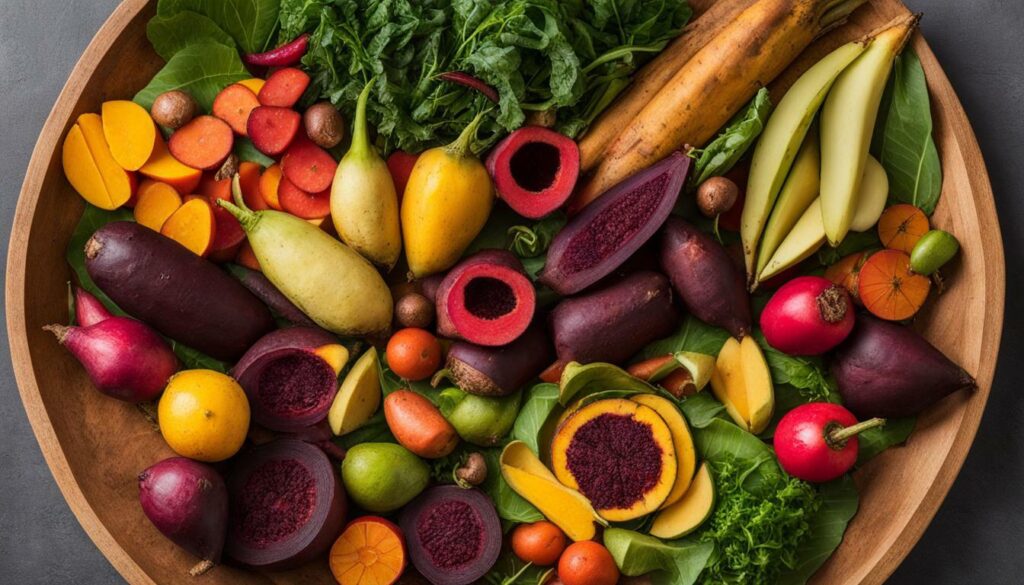
The culinary tradition of Central Africa goes beyond individual ingredients and dishes. It encompasses the techniques and methods used in cooking, as well as the social and cultural aspects of food preparation and consumption.
Central African cuisine often involves communal cooking and sharing of meals. The preparation of traditional foods is often a collaborative effort, with family members or community members coming together to cook and enjoy a meal. This sense of community and togetherness is an integral part of Central African culinary tradition.
“Food is not just about sustenance; it is a way of connecting with others, celebrating traditions, and preserving cultural heritage.”
Central African culinary tradition also emphasizes the use of fresh and locally sourced ingredients. Many traditional dishes are made using ingredients that are readily available in the region, such as fruits, vegetables, grains, and locally caught fish or game. This emphasis on locally sourced ingredients not only adds flavour and uniqueness to the dishes but also promotes sustainable and eco-friendly eating practices.
As Central Africa continues to evolve and adapt to modern influences, preserving and celebrating its culinary traditions is important. Traditional foods and culinary practices not only provide a link to the region’s rich history but also contribute to the cultural identity and heritage of Central Africa.
Evolution of Central African Diets
The Nile Valley in Northern Africa has historically been a rich source of fish, animals, and plant food. This abundance of resources, along with the region’s fertile land, has played a significant role in shaping the evolution of Central African diets. With a diverse range of cultures and culinary traditions, Central Africa has seen a gradual incorporation of new foods and dietary practices over time.
Early civilizations in Central Africa relied heavily on hunting and gathering, with communities adapting to their environments and utilizing local resources. As agricultural techniques developed, the cultivation of staple crops such as maize, millet, sorghum, and yam became more widespread. These crops formed the foundation of Central African diets, providing sustenance and nourishment to the local populations.
With the arrival of European colonizers, new ingredients and cooking methods were introduced to the region. Spices, herbs, and vegetables from Europe and Asia found their way into Central African kitchens, adding new flavours and culinary possibilities. European staples such as wheat, rice, and potatoes also gained popularity, further diversifying the local diet.
| Staple Crops | Traditional Ingredients | European Influences |
|---|---|---|
| Maize | Palm oil | Wheat |
| Millet | Groundnuts | Rice |
| Sorghum | Cassava | Potatoes |
| Yam | Plantains | N/A |
Today, Central African diets continue to evolve, influenced by globalization, urbanization, and changing lifestyles. While traditional ingredients and cooking methods remain important, the availability of processed foods and fast food chains has led to a shift in dietary practices. This transition has raised concerns about the impact on health and nutrition, as processed foods often lack the nutritional value of traditional dishes.
Despite these challenges, there is a growing movement to preserve and promote traditional Central African diets. Organizations and individuals are working to raise awareness about the importance of local ingredients, traditional cooking methods, and the nutritional value of traditional dishes. By embracing their culinary heritage and incorporating modern approaches to nutrition, Central Africans can maintain a balanced and healthy diet while celebrating the rich flavours and cultural significance of their traditional cuisine.
References:
- “Central Africa.” Food and Agriculture Organization of the United Nations. Accessed November 10, 2021. http://www.fao.org/home/en/.
- “Traditional Food in Central Africa.” African Food Revolution. Accessed November 10, 2021. http://www.africanfoodrevolution.org/.
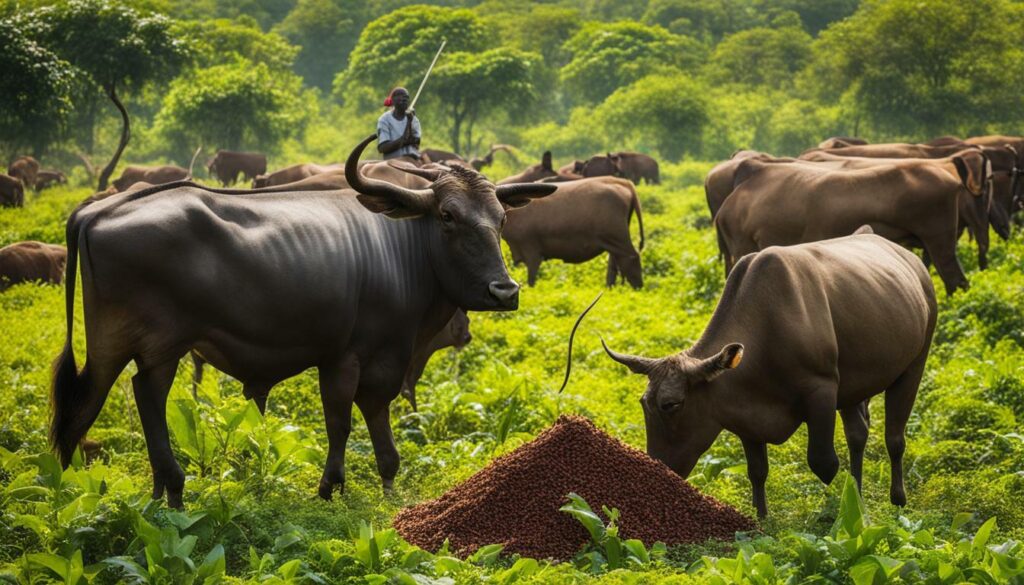
In the drier African savannas, nomadic tribes raised cattle, goats, and sheep, while cereals and tubers slowly became popular throughout the continent. This diverse landscape and cultural heritage have greatly influenced the cuisine of Central Africa, resulting in an array of delicious and unique dishes. From hearty stews to flavorful sauces, Central African cuisine is a celebration of local ingredients and traditional cooking techniques.
One of the most beloved dishes in Central Africa is Poulet DG, which translates to “Director’s Chicken.” This mouthwatering dish is a savoury combination of flavorful chicken pieces, vibrant vegetables such as bell peppers and carrots, and aromatic spices like garlic, ginger, and thyme. The ingredients are cooked together in a rich tomato-based sauce, creating a tantalizing aroma that fills the kitchen. Poulet DG is typically served with a side of rice or plantains, providing a satisfying and well-rounded meal.
Another popular dish is Saka Saka, a hearty and nutritious stew made with cassava leaves. The leaves are finely chopped, then cooked with a variety of meats such as beef, fish, or smoked fish, and seasoned with onions, garlic, and palm oil. The result is a flavorful and comforting stew that is often enjoyed with fufu, a dough made from yam, cassava, or plantains. Saka Saka is a staple in Central African households, symbolizing warmth, community, and the love of good food.
No exploration of Central African cuisine is complete without mentioning Calulu, a traditional Angolan dish that has gained popularity across the region. Calulu is a hearty stew made with dried fish or meat, onions, tomatoes, okra, and palm oil. The ingredients are simmered together for hours, allowing the flavours to meld and create a rich, velvety sauce. Calulu is typically served with funge, a thick cornmeal porridge, and is enjoyed by families and friends as a comforting and nourishing meal.
| Dish | Description |
|---|---|
| Poulet DG | A savoury chicken dish cooked with vegetables and aromatic spices, often served with rice or plantains. |
| Saka Saka | A stew made with cassava leaves and a variety of meats, enjoyed with fufu. |
| Calulu | A hearty stew made with dried fish or meat, okra, and palm oil, typically served with funge. |
These are just a few examples of the popular dishes found in Central African cuisine. Each dish represents a unique blend of flavours, influenced by the region’s diverse cultural heritage and natural abundance of ingredients. Whether you’re craving a comforting stew or a flavorful chicken dish, Central African cuisine offers a wide range of delicious options that are sure to satisfy your taste buds.
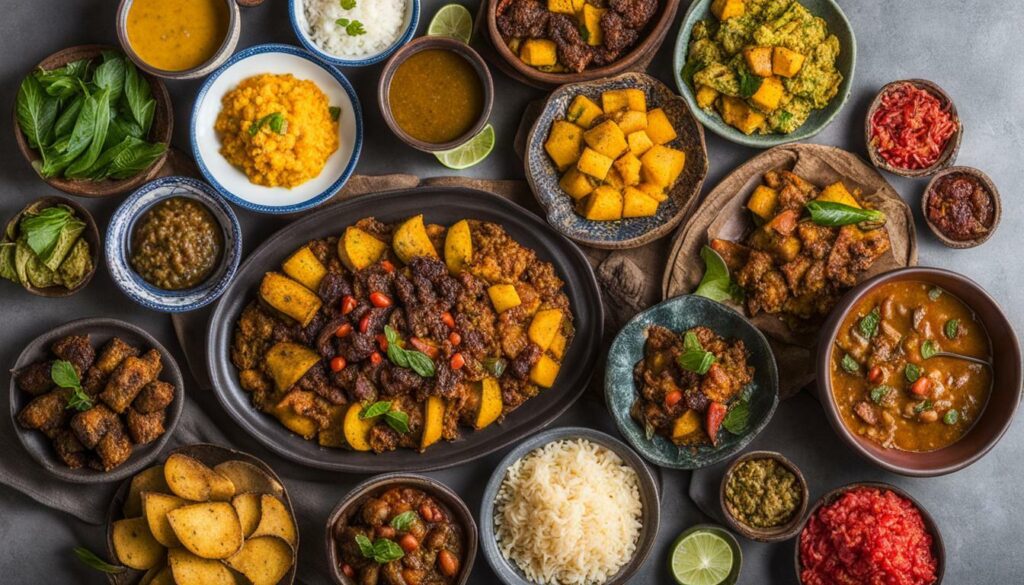
Central Africa boasts a rich culinary heritage, with popular dishes like Poulet DG, Saka Saka, and Calulu showcasing the region’s vibrant flavours and traditional cooking techniques. The combination of local ingredients, such as cassava leaves and palm oil, with aromatic spices and vegetables creates a diverse and delicious cuisine that is loved by many. Whether you’re exploring the cuisine of Central Africa or looking for a new culinary adventure, these popular dishes are a fantastic starting point to immerse yourself in the flavours of the region.
Culinary Traditions of Central Africa
Traditional cooking methods in Africa include steaming, boiling, frying, grilling, roasting, or baking. These methods have been passed down through generations and continue to shape the culinary traditions of Central Africa. One of the most common cooking methods in the region is stewing, which involves simmering ingredients in a flavorful liquid over low heat for an extended period. This slow-cooking technique allows the flavours to meld together, resulting in rich and hearty dishes.
Central African cuisine is known for its use of a wide variety of greens. Leafy vegetables such as cassava, okra, and pumpkin leaves are staples in many dishes. These greens not only add vibrant colours to the plate but also provide essential nutrients. Central Africans have been cultivating and consuming greens for centuries, recognizing their health benefits and culinary versatility.

Central Africa is home to a diverse range of cultural groups, each with its own unique food culture. Traditional recipes often feature a blend of local ingredients, herbs, and spices, creating a symphony of flavours. From fragrant stews to spicy sauces, Central African cuisine offers a taste experience that is both comforting and adventurous.
Central African Cuisine: A Celebration of Culture and Flavors
The culinary traditions of Central Africa are deeply rooted in the region’s history and culture. They reflect the resourcefulness and creativity of the people who have adapted to their environment over time. Traditional recipes, passed down through generations, tell stories of resilience, community, and connection with the land.
As you explore the rich tapestry of Central African cuisine, you’ll discover a treasure trove of flavours and textures. From traditional cooking methods to vibrant greens and aromatic spices, the food culture of Central Africa is a celebration of diversity and heritage. So, grab a seat at the table, savour the flavours, and immerse yourself in the culinary traditions that have shaped Central Africa.
| Key Features of Central African Cuisine |
|---|
| Stewing is a popular cooking method |
| Wide variety of leafy greens |
| A Blend of local ingredients, herbs, and spices |
| Reflects the region’s history and cultural diversity |
Influence of Islamic Traditions on North African Cuisine
The cuisine of North Africa is influenced by Islamic traditions, with staple foods including grains, olive oil, onions, and garlic. The Islamic religion plays a significant role in shaping the dietary practices of this region, as it emphasizes the importance of halal food and specific dietary restrictions. Islamic dietary laws, known as halal, dictate what is permissible and forbidden for Muslims to consume. This has led to the development of unique culinary traditions that are deeply rooted in Islamic culture.
One of the defining features of North African cuisine is the use of aromatic spices and herbs. Traditional dishes often incorporate a combination of flavours such as cumin, coriander, cinnamon, saffron, and mint, which are believed to have both culinary and medicinal benefits. These spices not only enhance the taste of dishes but also add depth and complexity to the overall flavour profile.
In addition to spices, grains are a fundamental component of North African cuisine. Wheat, barley, and couscous are commonly used in a variety of dishes, such as tagines and stews. These grains provide a hearty base for meals and are often supplemented with vegetables, legumes, and meat. Olive oil is another essential ingredient, used both as a cooking medium and as a flavour enhancer.

The incorporation of Islamic traditions in North African cuisine has resulted in a diverse and flavorful culinary landscape. The use of local ingredients, spices, and cooking techniques has given rise to a wide range of dishes that are enjoyed not only in the region but also around the world. From hearty stews to fragrant tagines, North African cuisine continues to captivate food enthusiasts with its rich flavours and cultural significance.
West African Staple Foods
In West Africa, rice is a predominant staple, while root crops such as yam and cassava are common along the coast. These foods have been a vital part of the region’s cuisine for centuries, providing sustenance and flavour to the diverse cultures that call West Africa home. Rice, in particular, holds a special place in West African cooking, with various rice dishes enjoyed across the region.
One popular rice dish is Jollof Rice, a flavorful one-pot meal made with rice, tomatoes, onions, peppers, and a blend of spices. This vibrant and aromatic dish is often served with grilled or fried chicken, plantains, or a side of vegetables. It is a staple at festive occasions and family gatherings, bringing people together to celebrate and enjoy the rich flavours of West African cuisine.
In addition to rice, root crops like yam and cassava are also widely consumed in West Africa. Yam is often boiled or mashed and served as a side dish, while cassava is used to make fufu, a dough-like staple that is eaten with soups and stews. These versatile and nutritious root crops provide an essential source of carbohydrates and nutrients in the West African diet.
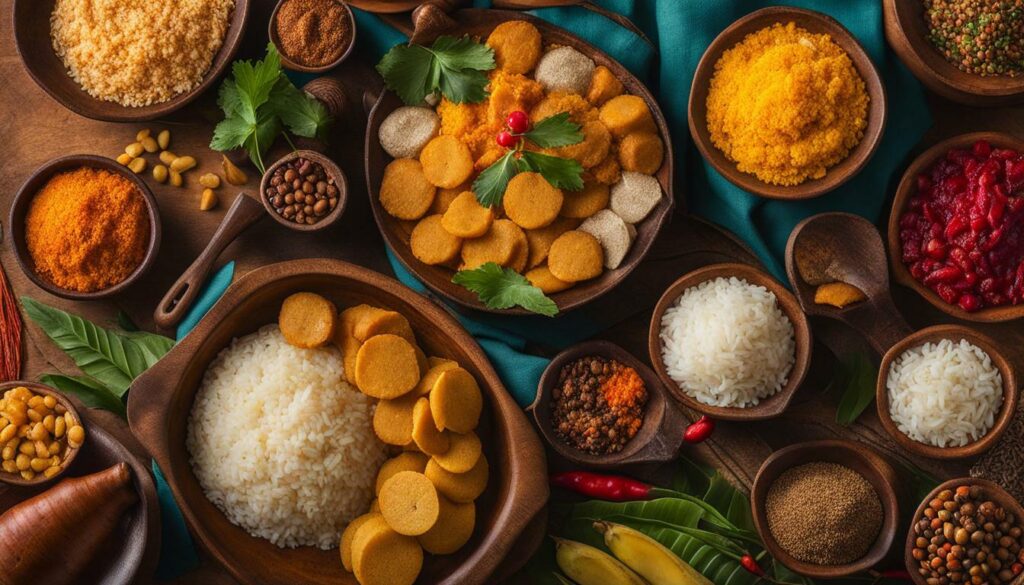
| Food | Description |
|---|---|
| Rice | White rice and Jollof Rice are popular rice dishes enjoyed throughout West Africa. |
| Yam | A starchy root vegetable boiled or mashed and served as a side dish. |
| Cassava | Used to make fufu, a dough-like staple eaten with soups and stews. |
As you can see, West African cuisine is rich in staple foods that form the foundation of meals in the region. The combination of rice, yam, and cassava provides a diverse range of flavours and textures, allowing for delicious and satisfying dishes. Whether it’s a comforting plate of Jollof Rice or a hearty serving of fufu with flavorful soup, West African staple foods are a testament to the region’s vibrant culinary heritage.
Fruits and Vegetables in Southern Africa
Fruits and vegetables in southern Africa include bananas, pineapples, mangoes, and tomatoes. These vibrant and flavorful fruits are widely consumed throughout the region and play an important role in Southern African cuisine. From refreshing salads to delicious desserts, fruits and vegetables are incorporated into a variety of dishes, adding a burst of freshness and nutrition.
South Africa, in particular, is known for its diverse range of fruits and vegetables. The country’s warm climate provides the perfect conditions for growing a wide variety of produce. In addition to bananas, pineapples, mangoes, and tomatoes, South Africa also boasts an abundance of citrus fruits such as oranges, lemons, and grapefruits. These citrus fruits not only add a tangy flavour to dishes but are also rich in vitamin C.
When it comes to vegetables, Southern Africa offers an array of options. Leafy greens like spinach and kale are popular choices, often used in stews and side dishes. Root vegetables such as sweet potatoes and carrots are also widely consumed, providing a hearty and nutritious addition to meals. Other commonly used vegetables include bell peppers, onions, and cabbage, adding colour and flavour to Southern African dishes.
Table 1: Popular Fruits and Vegetables in Southern Africa
| Fruits | Vegetables |
|---|---|
| Bananas | Spinach |
| Pineapples | Kale |
| Mangoes | Sweet Potatoes |
| Tomatoes | Carrots |
| Oranges | Bell Peppers |
| Lemons | Onions |
| Grapefruits | Cabbage |
Whether enjoyed on their own or incorporated into various dishes, fruits and vegetables are essential components of Southern African cuisine. Their vibrant colours, unique flavours, and nutritional benefits make them a delicious and healthy choice for those exploring the diverse culinary traditions of the region.
Stewing as a Central African Cooking Method
Stewing is the most common cooking method in Central Africa, with starchy staples often served with a sauce or stew. This traditional cooking technique involves simmering ingredients in a liquid over low heat for an extended period, allowing flavours to meld and intensify. The slow, gentle simmering ensures that meats and vegetables become tender and infuse the dish with rich flavours.
Central African stews are known for their depth of flavour and variety of ingredients. Commonly used meats include beef, goat, chicken, and fish, while vegetables such as okra, spinach, and pumpkin leaves add texture and nutritional value. These stews are often thickened with ingredients like groundnuts (peanuts) or cassava flour, resulting in a hearty consistency that makes them ideal for spooning over staple foods like rice, yam, or fufu.
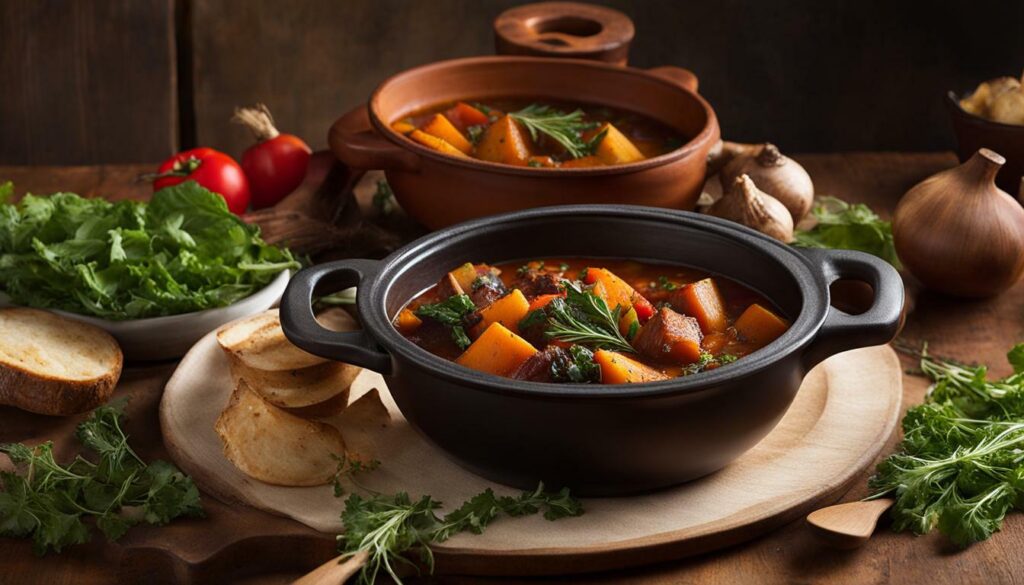
In addition to the ingredients, what makes Central African stews truly special is the combination of spices and herbs used. Popular seasonings include onions, garlic, ginger, and a variety of local spices like ndolé or djansang. These aromatic spices contribute to the distinctive flavours that make Central African cuisine unique.
| Common Ingredients in Central African Stews: | Popular Central African Stew Dishes: |
|---|---|
| Beef | Pepper Soup |
| Goat | Ndolé |
| Chicken | Eru |
| Fish | Saka Saka |
| Okra | Moyin Moyin |
| Spinach | Palm Nut Soup |
Stewing is not only a cooking method but also a representation of the rich cultural heritage and history of Central Africa. It showcases the resourcefulness of the region’s people, who have adapted their cooking techniques to the available ingredients and created flavoursome dishes that have stood the test of time.
Central African Greens
Greens are a distinguishing characteristic of Central African cooking, with a wide variety consumed including cassava, okra, and pumpkin leaves. These leafy vegetables are not only flavorful but also packed with essential nutrients, making them an integral part of the region’s cuisine.
Central African cuisine celebrates the abundance of greens by incorporating them into various dishes. One popular example is Pondu, a traditional Congolese dish made with cassava leaves. The leaves are boiled, pounded, and then cooked with palm oil, onions, garlic, and spices, creating a rich and hearty stew. Pondu is often served with fufu, a starchy staple made from cassava or plantains, providing a satisfying and nutritious meal.
In addition to cassava leaves, okra is another staple green in Central African cooking. Known for its slimy texture when cooked, okra is often used to thicken soups and stews. One well-known dish featuring okra is Muamba de Galinha, a popular Angolan chicken stew. The dish combines tender chicken pieces with okra, palm oil, tomatoes, and spices, resulting in a flavorful and comforting meal that showcases the versatility of this green vegetable.
Cassava Leaves Recipe
For an authentic taste of Central African cuisine, try this delicious recipe for Cassava Leaves Stew:
- Ingredients:
- 2 cups cassava leaves, washed and finely chopped
- 1 onion, diced
- 2 cloves garlic, minced
- 2 tablespoons palm oil
- 1 cup beef or chicken broth
- Salt and pepper to taste
- Instructions:
- In a large pot, heat the palm oil over medium heat.
- Add the diced onion and minced garlic, and sauté until fragrant and golden.
- Add the chopped cassava leaves and stir well to combine.
- Pour in the beef or chicken broth, then season with salt and pepper.
- Cover the pot and simmer for about 1 hour, stirring occasionally, until the leaves are tender and the flavors have melded together.
- Serve the stew hot with steamed rice or fufu for a complete Central African meal.
Central African greens not only add vibrant colours and flavours to dishes but also contribute to a nutritious and balanced diet. Incorporating these leafy vegetables into your cooking will not only introduce you to the diverse flavours of Central Africa but also provide you with a dose of vitamins and minerals.
| Benefits of Central African Greens |
|---|
| 1. High in Fiber: Cassava, okra, and pumpkin leaves are all rich in dietary fibre, aiding in digestion and promoting a healthy gut. |
| 2. Packed with Vitamins: These leafy greens are excellent sources of vitamins A, C, and K, which support immune health and overall well-being. |
| 3. Rich in Minerals: Cassava, okra, and pumpkin leaves are also packed with essential minerals such as calcium, iron, and potassium. |
| 4. Antioxidant Powerhouses: The greens contain antioxidants that help protect against cell damage and reduce the risk of chronic diseases. |
Next time you’re looking to add a nutritious and flavorful twist to your meals, consider incorporating Central African greens into your cooking. Whether it’s a comforting stew or a vibrant side dish, these leafy vegetables are sure to bring a taste of Central Africa to your table.

In conclusion, the past and present diets of Central Africa reveal a rich culinary tradition shaped by history, culture, and the availability of local ingredients. The region’s diverse cultures have contributed to a wide array of traditional foods, each with its own unique flavours and cooking methods.
Throughout history, Central Africa has been influenced by various cultural and environmental factors, resulting in the evolution of its cuisine. The introduction of new foods and the impact of cultural changes have shaped the diets of the region, leading to a fusion of flavours and culinary techniques.
Staple foods like rice, root crops, and leafy greens play a significant role in Central African cuisine. These ingredients are often stewed or served with flavorful sauces, creating hearty and nourishing meals. The use of meat and fish as ingredients further enhances the taste and texture of these dishes.
Furthermore, Central African food culture emphasizes the importance of communal dining. Lunch, the main meal of the day, is often shared with family and friends, fostering a sense of community and celebration. This shared experience allows for the exchange of stories, traditions, and the preservation of cultural heritage.
The Future of Central African Cuisine
As Central Africa continues to evolve, so too will its culinary landscape. The region’s rich history and cultural influences provide a strong foundation for exploring new flavours and experimenting with different cooking techniques. In recent years, there has been a growing interest in traditional African cuisines, both within the region and globally.
Restaurants specializing in Central African cuisine are emerging, offering diners the opportunity to experience the unique flavours and dishes of the region. Additionally, there is an increased emphasis on sustainable and locally sourced ingredients, supporting local farmers and preserving traditional farming practices.
Overall, the past and present diets of Central Africa reflect a vibrant and ever-evolving culinary landscape. By appreciating and embracing the rich food culture of the region, we can not only celebrate its history but also contribute to its future prosperity.
FAQ
What is the history of food in Central Africa?
The history of food in Central Africa is rich and diverse, with a long tradition of food production and adaptation to diet. Adapting to different environments and cultural influences has shaped the evolution of diets in the region.
What are the traditional foods in Central Africa?
Traditional foods in Central Africa include a mixture of vegetables, legumes, and occasionally meat. Stews and sauces are commonly used to enhance the flavours, which are then served over a porridge or mash made from root vegetables or grains.
How have Central African diets evolved over time?
Central African diets have evolved over time with the introduction of new foods and the impact of cultural changes. Cereals and tubers slowly became popular throughout the continent, while influences from Islamic traditions and European colonization have also played a role.
What are some popular dishes in Central African cuisine?
Some popular dishes in Central African cuisine include different types of stews, grilled meats, and various vegetable dishes. The cuisine is known for its diverse flavours and use of local ingredients.
What are the culinary traditions of Central Africa?
Central African culinary traditions include a variety of cooking methods such as steaming, boiling, frying, grilling, roasting, or baking. Stewing is particularly common, and greens are a distinguishing characteristic of Central African cooking.
How has Islamic tradition influenced North African cuisine?
Islamic traditions have had a significant influence on North African cuisine. Staple foods in North Africa include grains, olive oil, onions, and garlic, reflecting the influence of Islamic dietary practices.
What are the staple foods in West Africa?
Rice is a predominant staple in West Africa, accompanied by various vegetables and proteins. Root crops such as yam and cassava are also common, particularly along the coast.
What fruits and vegetables are commonly found in Southern African cuisine?
Fruits and vegetables commonly found in Southern African cuisine include bananas, pineapples, mangoes, and tomatoes. These ingredients add vibrant flavours to the dishes.
What is the common cooking method in Central Africa?
Stewing is the most common cooking method in Central Africa. It involves simmering ingredients slowly in a liquid, often resulting in rich and flavourful dishes.
What are some popular greens in Central African cooking?
Central African cooking incorporates a wide variety of greens, including cassava, okra, and pumpkin leaves. These greens add nutritional value and unique flavours to the dishes.
Source Links
- https://www.encyclopedia.com/food/news-wires-white-papers-and-books/africans-diets
- https://www.encyclopedia.com/food/encyclopedias-almanacs-transcripts-and-maps/central-africa
- https://journals.openedition.org/afriques/1857
Read Our Articles On The Other Regions of Africa Here:
| Past and Present Diets of North Africa |
| Past and Present Diets of West Africa |
| Past and Present Diets of East Africa |
| Past and Present Diets of Southern Africa |
| Past and Present Diets Sub-Saharan Africa |



